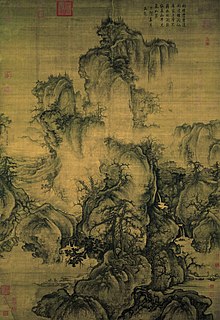Guo Xi
Guo Xi (Chinese: 郭熙; pinyin: Guō Xī; Wade–Giles: Kuo Hsi) (c. 1020 – c. 1090)[1] was a Chinese landscape painter from Henan Province[2] who lived during the Northern Song dynasty. One text entitled "The Lofty Message of Forest and Streams" (Linquan Gaozhi 林泉高致) is attributed to him. The work covers a variety of themes centered on the appropriate way of painting a landscape. He was a court professional, a literatus, well-educated painter who developed an incredibly detailed system of idiomatic brushstrokes which became important for later painters. One of his most famous works is Early Spring, dated 1072. The work demonstrates his innovative techniques for producing multiple perspectives which he called "the angle of totality." This type of visual representation is also called "Floating Perspective", a technique which displaces the static eye of the viewer and highlights the differences between Chinese and Western modes of spatial representation.
The following is an excerpt from his treatise, "mountains and waters":
Guo Xi was often referred to as a "Northern Song master" when it came to painting. His work inspired many later artists and he even had landscapes dedicated to him. His lesser-known "Deep Valley" scroll painting depicts a serene mountain valley covered with snow and several trees struggling to survive on precipitous cliffs. The ink washes and amorphous brush strokes are employed to model surfaces that suggest the veiling effects of the atmosphere. One of Guo Xi’s techniques was to layer ink washes to build up forms and his "Deep Valley" is a masterpiece of the use of light ink and magnificent composition.[4]
His son later described how Guo Xi approached his work: "On days when he was going to paint, he would seat himself at a clean table, by a bright window, burning incense to right and left. He would choose the finest brushes, the most exquisite ink; wash his hands, and clean the ink-stone, as though he were expecting a visitor of rank. He waited until his mind was calm and undisturbed, and then began."[5]
See also[edit]
Notes[edit]
- ^ Barnhart: Page 372. Guo Xi's style name was Chunfu (淳夫)
- ^ Ci hai: Page 452
- ^ The Rise and splendour of the chinese empire, rene grousset, p. 195
- ^ Hearn, Maxwell K. Cultivated Landscapes: Chinese Paintings from the Collection of Marie-Hélène and Guy Weill. New York: The Metropolitan Museum of Art, Yale University Press, 2002.
- ^ Quoted by Arthur Waley in "Chinese Philosophy of Art-IV" in Burlington Magazine, vol. xxxviii, No. ccxviii, p. 247 in Jenyns, Soame. A Background to Chinese Painting. New York: Schocken Books, 1966, p. 134
References[edit]
- Barnhart, R. M. et al. (1997). Three thousand years of Chinese painting. New Haven, Yale University Press. ISBN 0-300-07013-6
- Ci hai bian ji wei yuan hui (辞海编辑委员会). Ci hai (辞海). Shanghai: Shanghai ci shu chu ban she (上海辞书出版社), 1979.
- Guo Xi's Early Spring
곽희
 | |
예술가 정보 | |
| 출생 | 1020년 원현 |
| 사망 | 1090년 카이펑시 |
| 직업 | 화가, 작가 |
| 자녀 | 곽사 |
주요 작품 | |
영향 | |
곽희(郭熙, 1023년~1085년)는 중국 북송(北宋)의 화가이다. 자(字)는 순부(淳夫), 허난성 원 현 출신이다.
북송 초기, 각지에서 성립한 3인의 화풍 사이에는 상호간의 영향관계는 인지될 수 없으나 이성(李成), 범관(范寬)의 북방계(北方系) 산수화의 이념과 양식은 신종 시대의 화원 화가 곽희에 의해 통일, 집대성되었다. 평원(平遠=水平視)·고원(高遠=仰視)·심원(深遠=俯瞰視) 등의 갖가지 시점에서 포착한 자연을 동일화면에 설정하는 3원법(三遠法)을 위시하여 아침(朝), 저녁(暮), 맑음(晴), 비(雨)의 광선이나 연무(煙霧), 4계의 구별까지도 표현을 가능케 한 기법의 완성자로서 높이 평가되었다.
작품[편집]
郭煕(카쿠키, 1023-1085 ) 는 북송 의 산수화 가 글자 는 아츠오.
약력 [ 편집 ]
효주 온현 출신. 노년이 될 때까지의 경력은 거의 모른다. 신종 시기 초반에 등용된다. 미야나카에 올라가면 , 산지의 소금철 부사인 우충 의 명령 으로 관 과 궁전·사원의 벽화와 대병풍을 많이 제작했다. 곽희의 참신한 대화면의 화풍은 혁신의 뜻에 불타는 젊은 황제를 감동시켜, 얼마 지나지 않아 어서원의 예학 포스트에 오르고, 수년 후에는 서화 담당기관의 최고위인 대기예로 승진했다. 곽희가 속한 어서원은 함림 학사원 의 하부조직으로 같은 함림원의 하위기관으로 통상 궁정화가가 소속하는 함림도화원 과는 다른 부국이다. 화가에게 서기관의 직을 준 것은 인습적이 되기 쉬운 화원에 구속되지 않고 곽희가 그 천분을 자유롭게 발휘할 수 있도록 하기 위한 신종 스스로의 배려라고 한다.
신종사후 활동기록은 적다. 지지자를 잃고, 기교주의적인 곽희의 그림은 사대부 들의 미의식과는 맞지 않게 되었다. 이미 휘종 시기에는 잊혀지려고 하고 있으며, 동백 이 저술한 '화계'에는 곽희의 벽화와 병풍은 궁전에서 철거되어 폐품으로 취급된 일화가 보인다.
화풍과 그 영향 [ 편집 ]
곽희는 산수화에 길고, 깊고 자연스럽게 통하여, 「질유기간, 역력라열 동흉중(자연을 이해하는 최선의 방법은, 스스로 이 산에 놀아 관찰하는 것이다. 산수의 모습이 있어 가슴 속에 전개한다)」라고 하는 말을 남기고 있다 [1] . 운두봉 · 게 손톱수 라고 불리는 특수한 화법으로 산수화를 그려 그 산수는 소소·황정견 · 왕안석 등 의 높은 평가를 얻었다. 중국 산수화 사상 가장 중요한 산수화가로 꼽힌다. 후세 이성 이라고 병칭하여 '이곽'이라고도 불리며, 그 독특한 산수양식은 ' 이곽파 '라고도 불리며 이원 · 거연 한 '동거풍격'과 나란히 중국산수화를 대표하는 두 2개의 작풍으로 여겨진다.
그 가장 중요한 작품에 ' 조춘도 '(타이베이· 국립고궁박물원 )가 있다. 또, 그 산수화의 화론에, 아이의 곽사가 편찬한 「림천 고치집」( 중 )이 있어, 그 후의 중국 화론에도 큰 영향을 주었다.
참고 자료 [ 편집 ]
- 신토 타케히로「산수화란 무엇인가」후쿠무 서점 , 1989년 ISBN 4-8288-3301-3
각주 [ 편집 ]
- ^ 郭煕『林泉高地』의「山水訓」으로 보이는 말. 번역은 “아오키 마사아 전집:6”(춘추사, 1969) 참조



